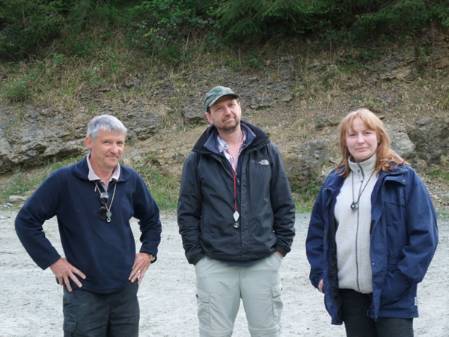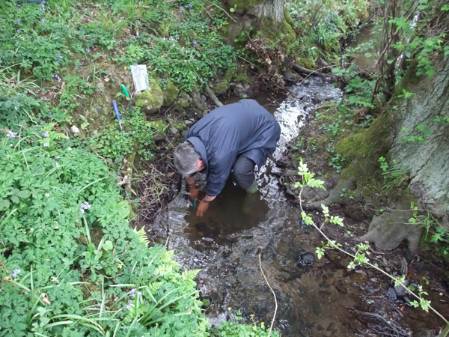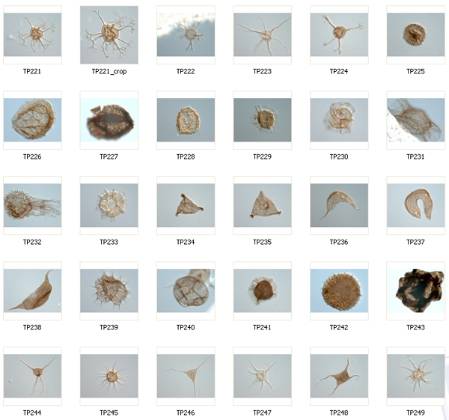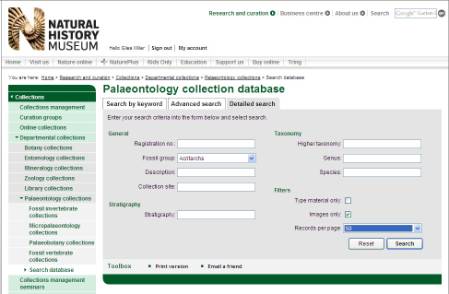Making a reference collection, taking high quality images of key species, identifying them and publishing the images on the web and in peer reviewed scientific articles are all ways in which expertise can be locked up in the Museum collections. NHM Scientific Associate Tim Potter has been doing just this during his time at the Museum. He studies acritarchs which are an enigmatic group of organic plankton that are present in marine rocks up to 3 billion years old.
Some Lower Palaeozoic acritarch images created by Museum Scientific Associate Tim Potter. In general acritarchs range from about 5 to 200 micro meters.
Although we don't know exactly what acritarchs are (the name means unknown origin), they are very important organisms as many are probably primary producers and therefore could be responsible for generating oceanic organic carbon in some of the earliest oceans including the Cambrian Period roughly 500 million years ago. The Cambrian Period was an exciting time for the development of life with many strange organisms arriving and subsequently becoming extinct during the 'Cambrian Explosion' of life. Like many microfossil groups, the acritarchs have potential for dating rocks and subsequently the timing of some of these important events.
Acritarchs can also tell us about conditions in some of these ancient oceans; periods of glaciation and major oceanic carbon fluctuations are known to have occurred. Carbon isotopic studies of rocks suggest that the global carbon cycle was disrupted in the late Cambrian about 500 million years ago with increased carbon in the oceans at this time. This is referred to as the SPICE event but the link between this event and acritarch diversity is yet to be proven.
Tim studied acritarchs of Cambrian age for his PhD prior to a long career with Shell. After retiring he decided to publish the findings of his thesis and came to the museum to update his identifications using the amazing resources we hold like the John Williams Index of Palaeopalynology. In February, Tim published a key paper on acritarchs with co-authors Susanne Feist-Burkhardt and Museum PhD student Brian Pedder, expanding on work done by Brian for his masters project.
Tim Potter, Brian Pedder and Susanne Feist-Burkhardt lined up by chance 'in publication name order' in the Welsh Borderland during a collecting trip for acritarchs.
Back in 2007, Tim, Susanne, Brian and myself carried out fieldwork specifically to collect samples to fill gaps in the Museum acritarch collections and to support Museum research that was being undertaken at the time. This fieldwork covered classic sites in the Lower Palaeozoic of the Welsh Borderland from the Cambrian to Silurian periods roughly 500-420 million years ago.
Tim Potter collecting a sample from the bottom of a stream near Comley, Shropshire. There are very few exposures of Cambrian rocks in the world and in the UK you have to search hard to find potential sampling sites. This is not an uncommon situation for Lower Palaeozoic fieldwork in the Welsh Borderland!
To obtain acritarchs from the rock samples collected, laboratory processing using nasty acids like hydroflouric acid is neccessary. It is not a particularly strong acid but it is deadly as it dissolves pretty much everything apart from the organic constituents of rocks. Splash a bit on yourself and you would not last long! A laboratory with special fume cupboards and much protective clothing is neccessary for processing samples safely. Fortunately for Tim, these samples were expertly prepared by technician Jonah Chitolie.
Once processed, the residues were analysed by Tim and single specimens picked out so that they could be mounted and viewed on glass slides. Because the specimens are so small, this is a particularly fiddly technique that requires a lot of patience. Most slides of acritarchs are strew mounts; a small amount of processed organic sample is pressed and cemented between two glass slides using resins like Canada Balsam. For these types of slides, an assemblage is preserved rather than a single indentifable specimen.
Some images of acritarchs from the Museum database.
The single grain slides that Tim produced have been photographed and the details and photographs released on the web via our specimen registration system. Tim has been happy with the identifications of most of the Cambrian specimens but would welcome comments on identifications of some of the younger Ordovician and Silurian examples. The Museum database is able to record re-identifications. It is hoped that other experts will log onto this resource and suggest alternative indentifications or back up the published indentifications, further increasing the value of this resource.
The Palaeontology Department on-line specimen database search screen
To find these details, log onto our specimen database system and choose 'acritarchs' in the drop down list for 'fossil group' and click the box for 'images only' (as above). Tim is constantly adding more material to the collections so hopefully in the years to come this will develop into a very useful resource for students of acritarchs and help to ensure that important expertise is not lost.
Postscript. As I was writing this I was sent details of a PhD studentship on acritarchs based at the University of Lille, France.







